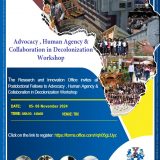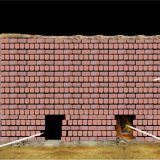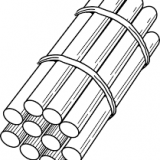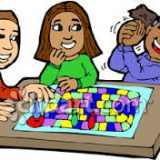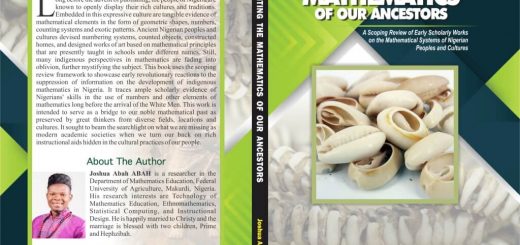The Traditional I’tche (Mancala) Board Game of the Orokam People
![]()
The I’tche game of the Orokam people is the ancient mancala game, so common among the people that the term “I’tche” in the Idoma language means “game”. It is obviously the first game every Orokam child learnt to play since it can easily be replicated on the hard ground by digging little holes and filing them with the required number of stones.
 The I’tche game has many name across Nigeria and much of Africa. The Yoruba people of southwest Nigeria calls it ayo while the Igbo people in southwest calls it Okwe. The Tiv people of Benue, Nigeria, calls it ateratar dar. OpenLearn Works (2016) provide series of name for the game such as Moruba (the pedi of South Africa), kpo (vai people of Sierra Leone and Liberia ), ajua (luo in Kenya), omweso (Ganda of Uganda), bao (Swahili in East Africa), gambatta (Ethiopia), and warri (Ashante in Ghana). Basically, the variant of the mancala game played across Nigeria is a board game comprising of a two rows of six holes or pots (2 by 6) containing four seeds (or stones) each. The board is usually carved on a rectangular wooden surface, but several artistic designs of the board exists, often depicting the status of the owner or group of players[1].
The I’tche game has many name across Nigeria and much of Africa. The Yoruba people of southwest Nigeria calls it ayo while the Igbo people in southwest calls it Okwe. The Tiv people of Benue, Nigeria, calls it ateratar dar. OpenLearn Works (2016) provide series of name for the game such as Moruba (the pedi of South Africa), kpo (vai people of Sierra Leone and Liberia ), ajua (luo in Kenya), omweso (Ganda of Uganda), bao (Swahili in East Africa), gambatta (Ethiopia), and warri (Ashante in Ghana). Basically, the variant of the mancala game played across Nigeria is a board game comprising of a two rows of six holes or pots (2 by 6) containing four seeds (or stones) each. The board is usually carved on a rectangular wooden surface, but several artistic designs of the board exists, often depicting the status of the owner or group of players[1].

Typical Mancala Board
The Orokam people calls the holes “ogo” while the seeds (i’kpo) are often gotten locally from tress that produce sizeable hardened seeds. The i’kpo could be cowries, pebbles or real plant seeds obtained from the African nut tree (Ricinodendron heudelotii) and I’tche tree (Caesalpina crisa). The two store houses (ole) at the edge of the board are meant for players to keep their captured seeds. The I’tche game is played by two players facing each other with the I’tche board in-between them. The side with six holes in front of each player belongs to him.
Basic Rule of Play in the I’tche Game
Four seeds are placed in each pot. The first player picks up all the seeds from any of their pots and sows them into the next four pots. No seeds are sown into the store. If the last seed is dropped into an opponent’s pot that contains only one or two seeds (no more) the player capture these seeds and the one he just placed in the pot and put them in his own store. Counting the last seed sowed, the pot contains two or three seeds, so it is capture by twos and threes (re’epa and re’eta; literally “eat two” and “eat three”). Remember a player can only capture on the opponent’s side and only if he is sowing his last seed in a pot that already holds either one seed or two. If there are three or more seeds no capture is made.
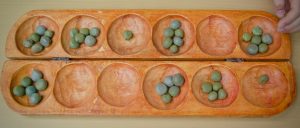
When a capture is made, the player also captures the seeds in the penultimate pot if it contains two or three seeds. If the pot before this one also contains two or three seeds the player can again make a capture. The player continues to capture in this way as long as the sequence is unbroken. The player may not capture on his own side of the board during this process. A player is not required to make a move that results in a capture, but if he does make such a move he must take the captured seeds and put them in his store. The number of seeds in each pot will vary dramatically as play proceeds. Enough seeds may accumulate in one pot to go round the board more than once. In this case the pot used for the beginning of the turn remains empty at the end of the turn (you skip over it). At any time, a player can count the seeds in any pot to help him plan a move. As the game draws to an end many pots will be empty.
The game can end when one side of the board is empty. If player 1’s side is empty then player 2’s seeds must be arranged in such a way that he cannot pass any seeds to the empty side of the board on his next move. The remaining seeds become the player 2’s. it is also possible for the last seeds to circulate with no capture possible. The player may agree to end the game and take each take half of the remaining seeds or they can be discarded. The player with the most seeds in his store wins.
Much of the description given so far is credited to the Africa Heartwood Project[2]. A diagrammatic explanation of the rule of play of the I’tche game and other background relationship to the cultural practices of the Orokam people can be downloaded here[3].
Mathematical Relevance of the I’tche Game
Present-day teaching methodology in mathematics hinges on mathematical proficiency. The central strands of mathematical proficiency are conceptual understanding, procedural fluency, strategic competence, adaptive reasoning, and productive disposition[4]. Consequently, the task of the mathematics teacher as a guide in the instructional process is to arrange experiences that will coherently build the strands of mathematical proficiency in the learner. This may entail the augmenting of instructional activities with mathematical objects and cultural artefacts that are relevant to the understanding of abstract concepts[5]. The I’tche game serves an enriching purpose as a cultural artefact if carefully engrafted into the pedagogy of mathematics, particularly at the basic education level.
In the I’tche game, one move pair is the combination of a player’s move and his opponents’ response. Children ultimately develop the ability to think three or more move pair deep, which means to envision what the game state might be after three more response. Given more time, they would have been able to use developed strategies consciously and at greater depth[6]. With each improvement in move pair depth, children develop their problems-solving skills over time. With experience, children begins to formulate intermediate goals, learn to consider more options and the set of possible responses, and search for patterns in the configuration of seeds on the I’tche board, to recognize a threat or an opportunity to harvest. These critical skills and the I’tche process of arriving at them constitute very useful assets for pupils in elementary schools. They are naturally aided in intuitiveness and procedural fluency whenever the game is used to augment certain topics in mathematics.
The I’tche game is an abstract strategy game involving little amount of chance. It enhances observational skills, critical thinking, planning ahead, spatial perception and number sense. Lowe[7] recognized counting, clock-arithmetic and basic arithmetic operations as the core topics of mathematics the I’tche game stand to enhance. Tembo[8] opined that the counting, piling up, and adding of stones strategically seems to mimic the use of exponentials. Also, considering the numerous possible moves that depend on many factors around I’tche, it can be asserted that the game has many elements of probabilities as well as conditional probability.
Although the I’tche game is normally played by two persons, the elementary mathematics teacher can redesign the pattern of play to accommodate any other convenient group size. In the process, members of the group will be able to collaborate, discuss tactics and strategy for short-term and long-term advantages. Lowe[7] suggested it could also be instructive to time the moves as this could indicate how fast the child is counting and how much problem-solving skills pupils have acquired. To provide more opportunities for children to develop mathematical ideals, the teacher can ask pupils to reflectively write about their playing strategies. Such schemes of mathematics instruction motivate schools children to learn and add a reasonable measure of aesthetic value to the subject.
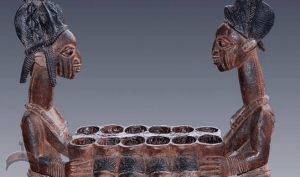
Carved Players
Traditional African values, such as sharing and saving face, are manifested in the rules of the game. The rules of play and harvest compel players to treat one another politely and with dignity[6]. These values are at the core of Nigerian education system, and recently imperatives in the wake of the economic recession have been re-directed towards vital socio-cultural revival[9]. Integrating traditional games into mathematics methodologies dose not only enhance mathematical proficiency in children, but result in the psycho-social well- being of future generations.
Mathematics learnt this way helps an individual in his character formation in many ways. It develop in the individual a proper attitude, as there is no space for prejudiced feelings, biased outlook, discrimination and irrational thinking, and aids him in objective analysis, correct reasoning, valid conclusion and impartial judgment[10].
References
- O’Connell, M. (n.d). Ayo: The Yoruba game board. Retrieved from http://www2.clarku.edu/~jborgart/discover/1meaghan/ayo.htm
- The African Heartwood Project. http://www.africaheartwoodproject.org/mancala-oware-african-board-games
- Abah, J. A. (2018). Mathematics in the cultural practices of the Orokam people of Nigeria: Insights into the educational relevance of the i’tche International Journal for Innovative Research in Multidisciplinary Field, 4(6), 164-171. A publication of Research Culture Society. Retrieved from https://www.researchgate.net/publication/326106658_Mathematics_in_the_Cultural_Practices_of_the_Orokam_People_of_Nigeria_Insights_into_the_Educational_Relevance_of_the_I%27tche_Game
- Kilpatrick, J. & Findell, B (2001). Adding it up: Helping children learn mathematics. Washinton, D. C. National Academy Press
- Abah, J. A. (2016). Recency bias in the era of big data: The need to strengthen the status of history of mathematics in Nigerian schools. Advances in Multidisciplinary Research Journal, 2(4), 241-248. Retrieved from http://media.wix.com/ugd/185b0a_9b1253273fea46768d1d96dcd03f4887.pdf
- Powell, A. B. & Temple, O .L. (2001). Seeding ethnomathematics with Oware: Sankofa. Teaching Children Mathematics, February 2001, 369-375.
- Lowe, N. K. (1988). Games and toys in the teaching of science and technology. Paris: UNESCO. pp 1-15
- Tembo, M. S. (2012). Mathematical analysis of the Nsolo Zambian – African game. Retrieved from http://m.info-barrel.com/Mathematical-Analysis-of-the-Nsolo-ZambianAfrican-Game
- Abah, J. A. (2016). Repositioning the pedagogy of the teaching practice course in mathematics education: Implications for stakeholders in a globally depressed economy. A paper presented at the 4th National Conference of the Faculty of Education, Benue State University, Makurdi, Nigeria, pp 1-11. Retrieved from https://files.osf.io/v1/resources/s7y8d/providers/osfstorage/582486966c613b01fde1c0e1?direct=true&action=download
- Thomaskutty, P. G. & George, M. (2007). Mathematics and civil society. Retrieved on 5th November, 2016, from http://math.arizona.edu/~atp-mena/conference/proceedings/Thomaskutty_Math_Civil_Society.doc
Views: 1757




